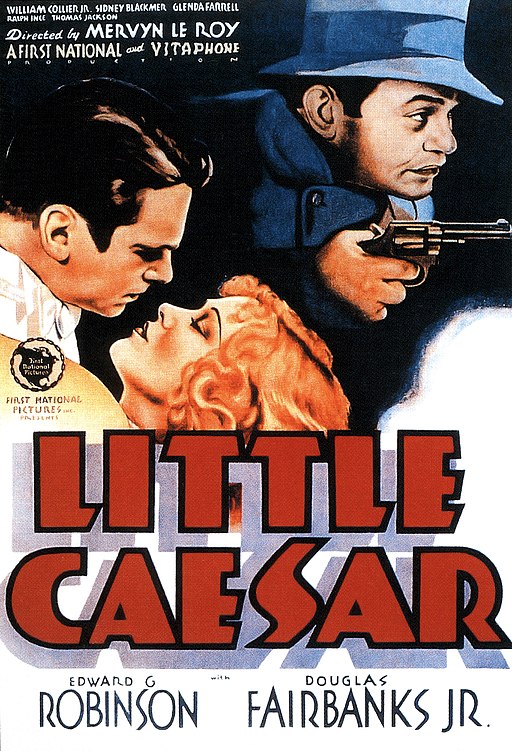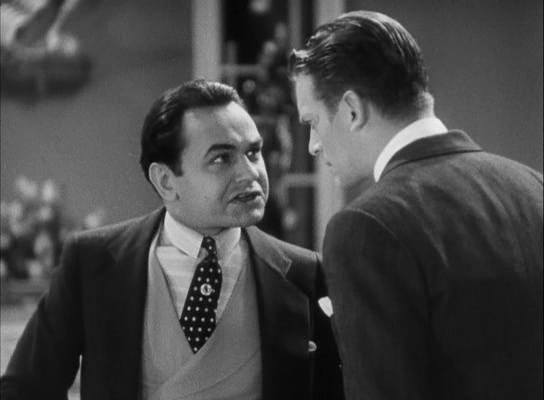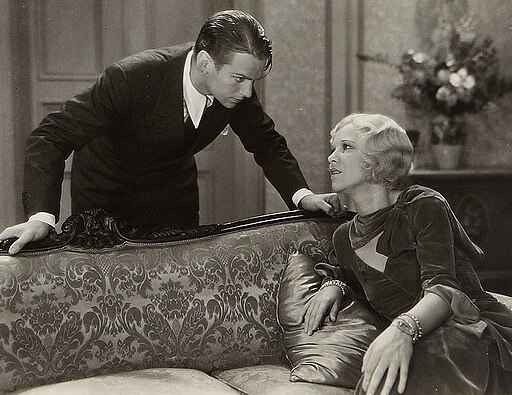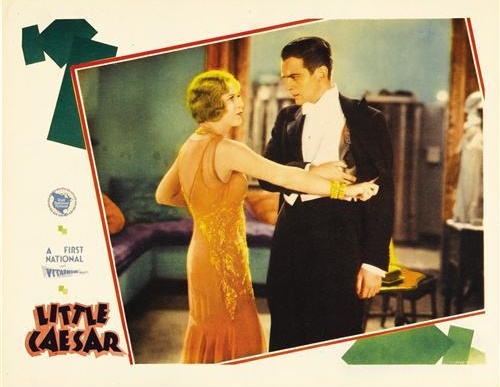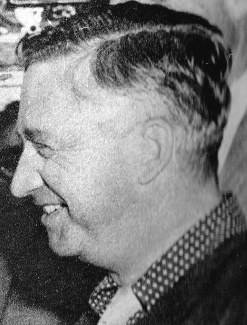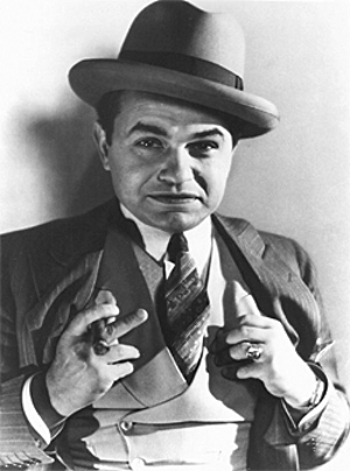Little Caesar - 1931
back| Released by | Warner Bros. |
| Director | Mervyn LeRoy |
| Producer | Hal B. Wallis, Darryl F. Zanuck |
| Script | Adapted by Francis Edward Faragoh and Robert N. Lee from the novel by W.R. Burnett |
| Cinematography | Tony Gaudio |
| Music by | No original score for the movie; however, music was selected and arranged by Erno Rapee |
| Running time | 79 minutes |
| Film budget | $ 281.000,- |
| Box office sales | $ 750.000,- |
| Main cast | Edward G. Robinson - Douglas Fairbanks - Glenda Farrell |
Little Caesar
One of the Iconic Gangster Movies
Little Caesar is a seminal film in the gangster genre, showcasing the rise and fall of a small-time criminal to a powerful mob boss, reflecting themes of ambition, power, and betrayal. The film is noted for its influential style and the strong performance of Edward G. Robinson.
Related
Little Caesar – 1931
Summary and Analysis
Summary:
"Little Caesar" follows the ambitious and ruthless rise of a small-time crook, Caesar Enrico Bandello, known as "Rico," portrayed by Edward G. Robinson in a career-defining role. The film opens with Rico and his partner Joe Massara (Douglas Fairbanks Jr.) holding up a gas station in the countryside. Unsatisfied with his life of petty crime, Rico decides to move to the city with dreams of becoming a big-time gangster.
In the city, Rico joins the gang of Sam Vettori, quickly asserting his dominance and ambition. His ruthless nature and cunning mind see him rise rapidly through the ranks, eventually taking control of the gang. Rico's insatiable hunger for power leads him to eliminate any obstacles in his path, including rival gang leader Tony Passa and his own former boss, Vettori.
While Rico ascends in the underworld, Joe Massara seeks a different path, pursuing a career in dancing and falling in love with Olga Stassoff (Glenda Farrell). Joe's attempts to distance himself from the criminal world put him at odds with Rico, especially as Rico becomes more paranoid and violent.
Rico's reign at the top is marked by brutality and fear, distancing him from his former friends and allies. His downfall begins when he refuses to leave town after being warned by the police. Despite his attempts to escape his fate, his past actions catch up with him. In the end, Rico is betrayed and finds himself cornered by the law. Wounded and alone, he utters the famous line, "Mother of mercy, is this the end of Rico?" before succumbing to his injuries, marking the fall of his criminal empire.
Analysis:
"Little Caesar" is a landmark film in the gangster genre, establishing many of the conventions that would define crime dramas for decades to come. Directed by Mervyn LeRoy, the film's fast-paced narrative and gritty realism were a departure from the more melodramatic films of the era, offering audiences a stark look at the allure and pitfalls of the American Dream.
Edward G. Robinson's portrayal of Rico is central to the film's success. His performance captures the complexity of a man driven by an insatiable desire for power and recognition, yet ultimately vulnerable to the very ambition that propels him. Rico's character arc, from a nobody to a gangster kingpin and then to his tragic end, mirrors the volatile nature of the criminal underworld and serves as a cautionary tale about the cost of unchecked ambition.
The film also reflects the socio-economic anxieties of the early 1930s, a time when the United States was grappling with the Great Depression. Rico's pursuit of power and success at any cost resonated with audiences facing economic hardship, highlighting the dark side of the American Dream.
Moreover, "Little Caesar" examines themes of loyalty, betrayal, and identity. Rico's relationships with Joe Massara and other characters illustrate the fragile nature of trust within the criminal underworld, where alliances are easily broken, and loyalty is often superseded by ambition.
In conclusion, "Little Caesar" not only established the template for the gangster genre but also offered a critical commentary on American society during the Depression era. Through its compelling narrative, complex characters, and thematic depth, the film remains a powerful and influential work in the history of cinema.
Classic Trailer of "Little Caesar":
Full Cast:
- Edward G. Robinson as Caesar Enrico "Rico" Bandello/Little Caesar
- Douglas Fairbanks Jr. as Joe Massara
- Glenda Farrell as Olga Stassoff
- William Collier Jr. as Tony Passa
- Sidney Blackmer as Big Boy
- Ralph Ince as Pete Montana
- Thomas E. Jackson as Sergeant Flaherty
- Stanley Fields as Sam Vettori
- Maurice Black as Little Arnie Lorch
- George E. Stone as Otero
- Armand Kaliz as De Voss
- Nicholas Bela as Ritz Colonna
- Charles Middleton as Diamond Pete Montana (uncredited)
- Lucille La Verne as Ma Magdalene (uncredited)
Analysis of the Direction of Mervyn LeRoy:
Mervyn LeRoy's direction in "Little Caesar" (1931) stands out for its innovative approach to storytelling, character development, and visual style, which collectively helped to define the gangster genre in early American cinema. LeRoy's work on this film is characterized by several key elements that demonstrate his directorial prowess and visionary approach.
Narrative Pacing and Structure: LeRoy's pacing of "Little Caesar" is brisk and efficient, capturing the rapid ascent and eventual fall of Rico Bandello. He wastes no time on extraneous subplots, focusing instead on Rico's ruthless climb to power and the consequences of his ambition. This focused narrative pacing keeps the audience engaged and underscores the inevitability of Rico's downfall, a central theme in gangster films.
Character Development: LeRoy excels in the development of complex characters, particularly the protagonist, Rico. Through a combination of tight script, Robinson's compelling performance, and LeRoy's direction, Rico emerges as a multifaceted character whose ambition, vulnerability, and brutality are all laid bare. LeRoy's ability to elicit such a nuanced portrayal from Robinson contributed significantly to the film's impact and to Robinson's lasting legacy.
Visual Style and Cinematography: LeRoy and cinematographer Tony Gaudio crafted a visual style that emphasizes the stark realities of the criminal underworld. The use of shadow and light, particularly in scenes of violence and tension, anticipates the visual motifs of film noir. LeRoy's framing and composition often isolate Rico, visually underscoring his alienation and moral descent. The visual style not only enhances the narrative but also contributes to the film's gritty atmosphere.
Thematic Depth: Under LeRoy's direction, "Little Caesar" explores themes of ambition, power, loyalty, and betrayal. LeRoy does not glamorize the gangster lifestyle; instead, he presents a critical view of the corrupting influence of power and the hollow pursuit of the American Dream. This thematic depth adds layers to the film, encouraging viewers to reflect on the motivations and consequences of Rico's actions.
Influence on the Gangster Genre: LeRoy's direction in "Little Caesar" helped establish the conventions of the gangster genre, including the rise-and-fall narrative arc, the portrayal of complex antiheroes, and the depiction of violence as a means to power. His innovative approach influenced countless gangster films that followed, setting a high standard for character development, narrative structure, and thematic exploration.
Superb Performance of Edward G. Robinson:
Edward G. Robinson's performance in "Little Caesar" (1931) is widely regarded as one of the defining moments of his career and a seminal portrayal in the gangster genre. His depiction of Caesar Enrico "Rico" Bandello, an ambitious and ruthlessly efficient gangster, showcases a depth of talent and complexity that set a new standard for character portrayal in early sound cinema.
Intensity and Charisma: Robinson's performance is marked by an intense charisma that captures the audience's attention from his first moments on screen. His embodiment of Rico's ambition and determination is palpable, drawing viewers into the narrative and making them complicit in his rise to power. Robinson's ability to project strength and authority with his voice and physical presence adds a layer of believability to his character's swift ascent in the criminal underworld.
Complex Characterization: What sets Robinson's portrayal apart is the nuanced complexity he brings to the role. Rico is not a one-dimensional villain; he is a man driven by insecurities and a deep-seated desire for respect and recognition. Robinson navigates these subtleties with skill, allowing moments of vulnerability to peek through the character's tough exterior. This multifaceted approach invites empathy for Rico, even as he commits increasingly ruthless acts, highlighting the tragedy of his eventual downfall.
Physicality and Expression: Robinson utilizes a distinctive physicality to embody Rico, employing gestures and facial expressions that convey a wide range of emotions without the need for extensive dialogue. His expressive eyes, in particular, communicate the character's thoughts and feelings effectively, from the cold calculation of his criminal endeavors to the paranoia and isolation that mark his final days. This physical expressiveness complements the film's visual style, enhancing the emotional impact of key scenes.
Iconic Vocal Delivery: Robinson's vocal delivery is another standout aspect of his performance. His distinctive voice, with its unique cadence and inflection, becomes a powerful tool for expressing Rico's ambition, confidence, and eventual desperation. The actor's delivery of the film's famous line, "Mother of mercy, is this the end of Rico?" is both haunting and poignant, encapsulating the character's tragic arc in a single moment.
Legacy and Influence: Edward G. Robinson's portrayal of Rico Bandello in "Little Caesar" established a template for the gangster archetype in American cinema. His ability to humanize a character that could easily have become a caricature paved the way for future actors and films within the genre. Robinson's performance remains a benchmark for actors portraying complex villains, demonstrating the power of cinema to explore the depths of human nature.
In conclusion, Edward G. Robinson's work in "Little Caesar" is a masterclass in film acting, blending intensity, complexity, physicality, and vocal skill to create a memorable and influential character. His portrayal of Rico Bandello not only defined his own career but also left an indelible mark on the gangster genre and the broader landscape of American film.
Memorable Quotes from the Movie:
- Rico Bandello (Edward G. Robinson): "Mother of mercy, is this the end of Rico?"
This line, delivered by Rico in his final moments, is perhaps the most famous from the film. It encapsulates his sudden realization of vulnerability and mortality, marking a stark contrast to his previously unshakeable confidence.
- Rico Bandello: "This is Rico speaking. Rico! R-I-C-O! Rico! Little Caesar, that's who! Listen, you crummy flat-footed copper, I'll show you whether I've lost my nerve and my brains!"
A defiant declaration from Rico, showcasing his arrogance and determination to prove his power to both his enemies and the authorities.
- Rico Bandello: "You can dish it out, but you got so you can't take it no more."
Rico says this to a former ally, highlighting a theme of the film: the gangster's rise is often marked by toughness and brutality, but their downfall is precipitated by an inability to endure the consequences of their actions.
- Rico Bandello: "Money's alright, but it ain't everything. Be somebody. Look hard at a bunch of guys and know that they'll do anything you tell them."
This quote reflects Rico's deep-seated desire for respect and power over others, illustrating his motivations beyond mere financial gain.
- Joe Massara (Douglas Fairbanks Jr.): "You know, this game ain't for guys that's soft."
Spoken by Joe, Rico's friend who seeks a different path, this line underscores the brutal reality of the gangster lifestyle and foreshadows the consequences that await those who cannot maintain their ruthlessness.
Classic Scenes from the Movie:
"Little Caesar" (1931) is filled with iconic scenes that have left a lasting impact on the gangster genre and cinema as a whole. These scenes are celebrated for their direction, performances, and their role in advancing the narrative. Here are a few classic scenes from the movie:
The Opening Gas Station Robbery:
The film opens with Rico Bandello (Edward G. Robinson) and Joe Massara (Douglas Fairbanks Jr.) robbing a gas station, setting the tone for the rest of the movie. This scene introduces audiences to Rico's ambition and foreshadows his rise in the criminal underworld. The scene's tension and the dynamics between the characters immediately grab the audience's attention.
Rico's Rise to Power:
A pivotal moment in the film is when Rico decides to challenge the current gang leadership to ascend in rank. His ruthless tactics and strategic mind are showcased as he orchestrates a takeover, demonstrating both his ambition and the brutality that will characterize his rise to power. This scene is crucial in establishing Rico as a formidable gangster leader.
The Party Scene:
During a party thrown by the gang, Rico's dominance is on full display. The dynamics within the gang and Rico's interactions with other characters reveal the complexity of his relationships and his manipulative nature. This scene also highlights the lavish lifestyle sought after by gangsters of the era, juxtaposed with the violence and ruthlessness that underpin it.
Rico's Refusal to Leave Town:
After being advised to flee because the police are closing in, Rico's refusal to leave town showcases his arrogance and denial of vulnerability. This scene marks the beginning of his downfall, as his overconfidence blinds him to the reality of his situation, setting up the film's climactic conclusion.
The Final Confrontation and Rico's Downfall:
The climax of the film, where Rico is cornered by the police, is one of its most memorable moments. His famous line, "Mother of mercy, is this the end of Rico?" is delivered here, encapsulating the character's realization of his mortality and the fleeting nature of his power. This scene is a powerful conclusion to Rico's story, showcasing the inevitable fall that follows his meteoric rise.
Rico and Joe's Confrontation:
The confrontation between Rico and Joe Massara highlights the themes of loyalty, betrayal, and the cost of ambition. As Rico's suspicion and paranoia grow, he confronts Joe, leading to a tense and emotionally charged scene that underscores the personal sacrifices made in the pursuit of power.
Recognition for Little Caesar:
"Little Caesar" (1931) is widely recognized as a classic in American cinema and a seminal work in the gangster genre. Despite its critical acclaim and lasting influence on film, it's important to note that the movie was released at a time when the modern system of film awards, most notably the Academy Awards (Oscars), had only just begun. The first Academy Awards ceremony was held in 1929, and the system for nominations and awards was quite different from today, with fewer categories and a different approach to recognizing films and filmmakers.
As a result, "Little Caesar" did not receive the kind of awards attention that might be expected for such a pivotal film if it were released in a later era. The film did not receive any Academy Award nominations. However, its success and impact were recognized in other ways, through its critical reception, its box office success, and its enduring legacy as one of the films that defined the early sound era of cinema and set the standards for the gangster film genre.
The legacy of "Little Caesar" is not marked by awards and nominations but rather by its significant contribution to cinema, its influence on subsequent films in the gangster genre, and Edward G. Robinson's iconic performance, which remains a touchstone for actors portraying complex villainous characters. The film's direction by Mervyn LeRoy, innovative for its time, has also been widely studied and praised in the years since its release.

